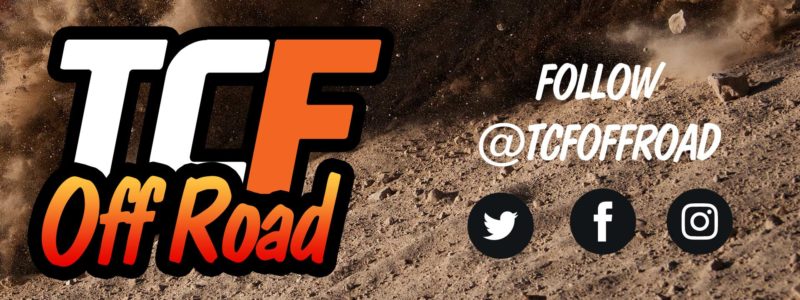Motorsports Racing News & Blog Articles
TRANSCRIPT: TCF Interview with Amy Lerner
The Checkered Flag got to speak with Amy Lerner, off-road racer and director of the film One More Win, on 29 April. The documentary profiles the legendary career of Rod Hall and his aspirations of running the 2017 SCORE International Baja 1000, which would be his fiftieth start dating back to the inaugural event in 1967.
Provided below is the full transcript of the interview. Some text has been altered from the original dialogue to improve readability and remove verbal pauses, though an audio version is available at the bottom.
An article summarising the interview can be read here.
Transcript
TCF: How did you get to know the Halls, and where, when, and how did the idea to create a documentary come to mind?
AL: I first met Rod Hall about a dozen years ago. I had read about this thing called the Rallye Aïcha des Gazelles, or the Gazelle Rally, in the newspaper, which was a nine-day, all-women’s navigation rally, and it just kind of sounded fun. It wasn’t anything that I had ever done. I had never driven off-road and I was having a moment, and decided to see if I could go and compete.
At the first training session down in the sand dunes in Southern California, I met this older guy who was there to do the training. Didn’t have any idea who he was. He was such a sort of humble, low-key guy and his teaching methods are, you know, he’ll show you something and then say, ‘Well, you know, what does Amy think about how we should do this?’ After a while, I was like, ‘Okay, this guy, I think he knows what he’s doing, but I’m not really sure he knows what he’s doing,’ until one evening.
We went to a restaurant in the area and walked in and we were waiting for a table and all of a sudden, I hear the whole restaurant going, “Rod Hall! That’s Rod Hall! It’s Rod Hall!” And I just looked, and I thought, ‘Okay, who the heck is this guy?’ Got home, googled him, and realised that I had just had the honour of getting my first driving training from an absolute legend in off-road motorsports. He and I stayed in touch after that and became friends and did a bunch of events together. As I got into more rally and racing, he really became a mentor to me.
I ran into him in 2015 at the Off-Road Motorsports Hall of Fame awards dinner. We were just chatting and catching up, and he was telling me that he was starting to maybe feel a little bit tired and thinking about retiring, but in two years, he would be racing his fiftieth Baja 1000. He was the only person who had raced every single Baja 1000 that had ever been run since the first one back in 1967, and he was feeling like that was a nice way to cap his career, and there were a lot of people that were hoping to see him do that. That night, I just sort of rolled around what we had talked about in my head with the fact that he is such a charismatic guy and had so many great stories of the history of the early days in off-road and desert racing.
I called him the next day and I said, “Hey Rod, I have this crazy idea. How about if I have a chance to make a documentary about your record-setting fiftieth Baja 1000 in 2017, along with the racing that you’re going to be doing in the two years leading up for that, and sort of wrap it around the history of off-road racing and your history in the sport and some of those great stories you’ve always talked about?” And he said he’d been asked over the years a lot of times, ‘Hey Rod, can I write a book about you? I want to do a biography, I want to do a movie,’ and he always said no, he didn’t feel the time was right. He said to me, ‘The time is right and Amy, because you’re the one that’s asking me, I’m going to say yes,’ so that was the beginning of One More Win.
TCF: Did you have any sort of filmmaking experience or just any involvement in the film industry, even if it’s not in a major role, before One More Win?
AL: I had zero. I had been approached a couple of years earlier by someone who was looking to do a documentary or a series about women who were doing off-road racing because at the time, there were still fewer of them than there are today, and had asked a lot of questions. So I know a little bit about the process but had never really studied it, done it, been in it. It was completely new.
TCF: According to your co-director Richard Heeley‘s website, this was also the first feature-length film that he directed, but he was already familiar with working on motoring series like Top Gear and Fifth Gear. How did you two connect, and how would you describe working with him on One More Win?
AL: One of the first people that I spoke my thoughts for One More Win was a friend and neighbour, the dad of a girl that my daughter was in school with, his name is Iain Greenway. He, by profession, is a brand specialist and did a lot of major brand redesigns, like he was responsible for the Survivor logo and a bunch of stuff. But he’s also a car guy, so I just started chit-chatting with him about my ideas. He said to me, ‘You know, I remember this guy that I was friendly with when we all worked at the BBC back in the day because he’s also British, Richard Heeley, and I know he went on and did a lot of other car-related stuff, and you’re in need of a co-director. Let’s talk to him and see if you guys get on and what it’s like.’
We hit it off. He was captured by the idea. In the beginning, I think he didn’t fully understand—as quite honestly, I didn’t—what a significant figure Rod Hall was in that world and the impact that he had on not just the fans, but the fellow racers and the shapes the sport itself took over the years. As we progressed through filming, he just became more and more captured by the story and, as you know from having watched the film, what Rod ended up going through with his health issues and his family. He really became just as engrossed in the story and with Rod as I was.
For me, it was amazing to have someone who had such an impressive résumé. It’s tough to get any better than Top Gear back in the day in terms of directing something on the automotive side, to have him willing to come on board and he’s got a super creative eye. The visual style that I wanted the film to take, I knew how to explain it but I didn’t know really how to make it happen or how to make the camera guys understand and the technical side of it, so his great experience that way and his creative eye, well, it was phenomenal that that was part of the project.
 Credit: Richard Heeley
Credit: Richard HeeleyTCF: Most of the film’s racing action focuses on Rod in the Mexican 1000 followed by two Baja 1000s, as well as you and Shelby Hall in the Mint 400. It’s obviously impossible to add every detail from every race to the film, but how did you and your crew know what to film and ultimately include in the final product?
AL: One of my big lessons for desert racing and even cross-country rally, any of these big off-road motorsports that take place over many, many, many miles: you don’t see a lot of documentaries, you don’t see a lot of footage, you don’t see a lot of TV coverage, and I realise because it’s pretty much impossible to fully cover a race. It’s not like they go around, the cars come past you and then you just wait a little bit of time, and they make the loop and ‘Woot, there they are again!’. Once they go by you, you’ve got to catch up to them and get in front of them and try to see what’s happening at the next mile or the mile after that. You got to get the camera set up, and it’s really difficult to capture everything that’s going to happen.
What we did was try to have as many different crews as the budget would allow and do a lot of work ahead of time with the race courses and the terrain map and the access and figure out where we thought either something might have a chance to happen with the team itself that would be interesting from a film perspective, or where we knew the terrain was going to be interesting so that visually what was going to happen as the car went past was going to be really cool to see.
The scene where Rod and Chris Collard get stuck in the sand was a super fortunate happenstance. It was right out of the town of Loreto, and we had a crew there and our drone operator. The car passes under a bridge and the drone operator was right next to the bridge. We just happened to have the drone right there and a variety of GoPros on the car, so we were able to catch that sequence because when you’re going down a thousand miles of a race, the odds that your crew is where the car will be when something happens—they hit a rock, they get stuck, they have a flat—it’s infinitesimal that that happened, so that was really a fortunate filming moment that that happened. But you spread your crews out, you do your research beforehand and you do your best to be where you think the best chances are that you’re going to capture something that’s either going to be interesting to watch or it’s going to forward the story as it’s unfolding.
TCF: I want to know the preparation and just the overall growing process. As both a desert racer and a filmmaker, do you feel that there are any strategies, methods, or mindsets in one that can be applied to working on the other?
AL: Yeah, absolutely, and it goes back to one of Rod’s favourite quotes: “To finish first, you must first finish.”
So you can’t just look at going fast. You can’t just look at looking cool in your race suit. You have to take the end goal and keep the end goal, which is to finish the race and cross the finish line because you don’t end up on the podium if you don’t cross the finish line, and if you don’t have the footage you need and your story planned out a bit ahead of time, you’re not going to end up able to make a film that anybody’s going to want to watch.
TCF: Let’s switch over to your own driving career then. How does it feel when you were driving Rod’s ’68 Bronco in the Mint 400 and getting on the podium? I’m sure it was a very special moment, but where would it rank in your racing career or even your life in general?
AL: I was a bit terrified. [chuckles] It was a very significant opportunity for me. Not only was it the chance to race in such a historically recognised vehicle that had a storied history of success in racing, it was also a chance to race with Shelby—she became a good friend of mine—and I believe that it was, in a way, a sign that Rod was okay with me driving his Bronco. He trusted me as a driver and it was also I think a little way of his saying thank you that I felt that his story was something that needed to be shared and captured and he was glad about that. And then of course, to do well and end up on the podium, just the whipped cream on the sundae.
 Credit: Richard Heeley
Credit: Richard HeeleyTCF: You also did the Dakar Rally and in the movie, Chad Hall said that the ’96 Rally was a horrible time for the team with how messy everything went. A lot has changed for the Rally since including where it’s held. For you, how would you describe the experience of not only racing there, but winning a stage in the Classic and doing so in a Porsche as part of an all-female driver line-up?
AL: That is one of the proudest moments of my racing career, just to use some hyperbole there, but it was. The race now takes place in Saudi Arabia. I don’t know if it’s bigger because of the way technology has changed. There’s better tracking, there’s more responsiveness if there are issues. I think the security of the race, just as a race for the racers, has evolved, and it’s better than it was back in the day. And also, the communication that you can get as a competitor from another country: you can email, there’s YouTube videos. There’s just so much more information that you can get ahead of time to prepare yourself for going and tackling something that’s quite as expansive and epic as the Dakar Rally.
TCF: However, in Saudi Arabia, there’s obviously a sort of stigma about women drivers that the country has kind of been trying to work against. Like they had the Rally Jameel a while back, which is an all-female rally. How did it feel to win in the Classic and basically add another chapter to that improving notion?
AL: Yeah, women have been driving in Saudi Arabia since I think 2018. I was over for Rally Jameel just as part of a media team, so it was really cool to see sort of the evolution of the opportunities for women in motorsport there. But as a woman in any kind of motorsport, it was also super cool, super important to have someone (say), ‘Hey, what happened in the Dakar Classic today?’ And look at the rankings, and the first picture is a woman for that day. It just kind of says, ‘You know what? There’s no reason why women can’t do this and can’t compete at the top of motorsports.’
That was neat to be able to have that achievement personally, but also to be able to just show up and show that accomplishment, that if I—you know, I’m not 22, I haven’t been doing this since I was six—if I can come in and achieve that, it’s possible for pretty much anybody. [laughs]
TCF: I know this is probably like having to pick your favourite child, but what would you consider as the bigger feeling or moment in your racing career: getting on the podium in the Mint or winning a stage in the Classic?
AL: I have to say that, just from the racing perspective, winning the stage in the Classic. We had come to that from year one, I didn’t really drive the car that well. I drove it okay, we finished, we did well, but I was determined to come back that second year.
Sara (Bossaert) and I, we put a lot of work in to learn not only the driving but learn the regularity, learn the format, learn to communicate with each other. We came back knowing we were going to want to do really well, and we were doing really well until I ran out of gas two kilometres before (the) finish line, which in a regularity rally the clock keeps ticking and you end up with some significant penalties, followed by a day that I got stuck on a little sand dune because I didn’t know it was coming and didn’t realise what was happening, and I unfortunately let my foot off the accelerator. In a two-wheel-drive sports car, where you’ve got the vast majority of the weight in the back, the second you do that in soft sand, you’re buried up to the axle. So we got huge penalties there. Those two days back-to-back meant that we had no chance of even a top ten unless something weird happened in the overall.
The day that we ended up winning the stage was the day after those two days. It was also, you know, we had to dig deep mentally and just say, “Okay, what we thought we were going to accomplish is off the table and there’s nothing we can do about it. But what can we still do?”
I’m super proud of Sara and myself that we did that and in that sequence of events was where that stage win fell, so that was pretty cool.
TCF: I believe Sara said that she had no rally experience whatsoever before the Classic.
AL: She barely drove a car. She barely drives her car. [chuckles]
When I decided to go six weeks before the entries closed for the 2021 Rally, I had another co-driver in mind and she, after a couple of weeks of deliberation, couldn’t go. I thought, ‘Well, I can get a pro co-driver in, but I also kind of want to have somebody in the car that I know I’m going to have a good time with because I’m not sure how this is going to work out competitively. Worst case, I’ll learn a lot and I’ll have a great adventure with somebody I like.’ So I sent her an email and about thirty-two seconds after I pressed send, she calls me and says, “I don’t know what you mean I need to do but sure, I’m going to go. I’m in, yes.”
And she’s now totally captivated and she’s hooked and she’s learned a ton. She did an incredible job, you know, she turned out to be really good at it and is looking forward to whatever the next rally is, she’s onboard.
TCF: Your off-road racing résumé has been steadily growing over the years with Dakar and the Mint. Are there any other races that you’d like to compete in the future, like the Mexican or Baja 1000 or even in a different discipline altogether like on pavement?
AL: I would love to do the Mexican 1000 one day. For me, I really enjoy that rally format, multiple days and multiple stages. Maybe the Baja 1000. The East African Safari Rally, which is a vintage rally that takes place primarily in Kenya, and a lot of muddy, dirty fun looking terrain and just completely different landscapes, that’s another one that I’ve got on my list.
TCF: I think the Mexican 1000 is actually this weekend as well, so it’s kind of fitting that we’re talking right now about it.
AL: Yeah, that’s going on this weekend. They call themselves “The Happiest Race on Earth”, but it really is. It’s just a fun time. And competitive, though. It’s a competitive event, but everybody’s got a great attitude and they’re there for fun and because they love it and they love their vehicle.
TCF: I recall in the film that there was a lot of camaraderie and a lot of crazy atmosphere, especially surrounding Rod when you were doing that race. How would you describe the atmosphere there yourself, having been there first-hand?
AL: The first time we filmed was at the Mexican 1000, and I was completely unprepared for what was going to happen when we walked into the convention center in Ensenada, and I was next to Rod. As soon as somebody noticed he was there, we could not walk two steps without someone coming up for a photo, for an autograph, they have to tell Rod a story, they have to ask Rod a question. I was blown away. I had no idea. Even having known him for so many years and been already deep into the dive of his history and the sport and seeing the headlines and the newspaper articles, I had no idea.
 Credit: Richard Heeley
Credit: Richard HeeleyTCF: On a more heavier note, Rod’s battle with Parkinson’s, especially when placed alongside him trying to run the fiftieth Baja 1000, yet you still handled it with a lot of respect. How much of a challenge was telling that side of the story?
AL: It was really hard to tell. It was a hard story to tell. It’s a difficult thing to watch for someone you don’t know. That was one of my bigger challenges as a filmmaker, to make sure that I kept a step back because this was still my friend who was going through these things and my friend’s friends and my friend’s family whom I had known. I think that relationship also gave us a lot of access and there was a lot of trust that allowed the family to share those moments that are so kind of impactful on camera because they trusted that I would treat it with respect and honour as you would hope that it would be handled.
We found out shortly after we started filming that Rod had something going on, but at his initial doctors, they said, ‘Oh, well, you know, you’re almost 80. When people get diagnosed this late, there tends to be a really slow progression.’ So we figured, ‘Well, we’ll just keep filming and we’re going to get as far as we’re going to get and there’s a ton of material to make some kind of cool biography.’
And it turned out to be more than a biography. The last race, it really was hard for Rod just to get to Baja.
TCF: And of course, even despite all of this, the movie ends on what I would call a triumphant and even inspirational note, with him finishing the race after everything he had been through. As someone who was there first-hand to witness his run from start to finish, how would you personally describe the emotions of that race and that moment when he finished?
AL: Oh my goodness. For me, when he got across the start line, I don’t know if you know this, but as soon as you cross the start in the seat of a race car in an event like this, you have officially competed in the race. So Rod, to have competed in the fiftieth of the fifty Baja 1000s, all he needed to do was be in the car as it crosses the start line. I was right with him at the start and when they crossed the start line, I basically started bawling from relief. That was it: he did it, officially for the record books, mission accomplished, and then we just had to get through the next thirty-six hours of racing.
There was trouble with the car, you saw that. Chad got very emotional because they didn’t know if the Hummer was going to make it the full way. Rod and Donna sat in that spot where you see him get lifted into the car for probably six hours because they originally thought the car was going to come by around 10, and it ended up that he crossed the finish line at I think 3:00 in the morning. I and the crews had been sitting there for four or five hours and the whole place looked deserted because there weren’t very many cars still crossing.
When Rod’s Hummer hit the little sort of lead-up to the finish line, word got out and as he pulled up onto the podium, I think a hundred people just swarmed his car. They had all been there, sleeping, napping, just waiting to experience that moment when he went across the finish line, for what a lot of people had a feeling was going to be his last ride.
 Credit: Richard Heeley
Credit: Richard HeeleyTCF: I think Curt LeDuc said in the documentary that there would not be a dry eye at the finish.
AL: That is what happened, yeah.
TCF: Would it be fair to describe One More Win as not just being a movie about Rod’s story, but also one intended to inspire audiences to pursue their dreams, no matter the challenges?
AL: Yeah, absolutely. Absolutely. That was something that we wanted to convey. Rod was a tough guy, and he had a lot of grit and intense throughout his whole career. He said that he was really down for quite a while and his physical abilities were very limited at that last race, but he was going to do it. He was going to do whatever he needed to do and bear whatever hardship he needed to bear to accomplish that, not just for himself, but for his family and the crews and the fans and the crowds and he was going to do it. His tenacity was something I was hoping was going to shine through.
TCF: While Rod is sadly no longer with us, have you kept in touch with the Halls since finishing production?
AL: Oh, yeah. Yep. Yep. I talk to Donna now and again, Shelby and I chitchat and she’s been real busy. She’s working as a brand ambassador for Bronco, for Ford, so she’s all over the country doing a great job with them. Chad is still racing, he’s got a programme with Chevy and he’s got two or maybe even he’s up to three vehicles now that he races, I think, the Best in the Desert series and some of the SCORE races.
TCF: Are there any future film projects that you have in mind, if not already working on?
AL: I’m actually just possibly joining a production already in progress that has to do with rally and women and some other interesting things. Sorry to be obscure, but it’s not official yet. [chuckles]
Interview audio
Copyright
© The Checkered Flag

 One More Win is legally available to watch online on
One More Win is legally available to watch online on  Follow @tcfoffroad on:
Follow @tcfoffroad on: